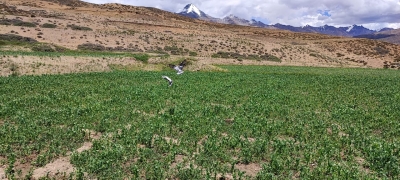Shimla: The disease-free high variety green peas crop, grown in natural conditions over the Himalayan peaks of Himachal Pradesh, is expected to drop by 30-35 per cent this season owing to scanty precipitation during the peak winter, say agriculture experts but the farmers are not complaining.
The reason: They are getting remunerative prices of Rs 70 to Rs 80 a kg in major markets in neighbouring states.
The decline in the crop is mainly attributed to inadequate snowfall during peak winter that led to scanty snow-fed water in the snow-fed irrigation system known as ‘kul’ — channels to carry water from the glacier to the fields — in the short summer of Spiti, a cold trans-Himalayan desert valley dominated by Buddhists.
The harvesting of the peas in the Spiti Valley, the paradise that straddles both India and Tibet comprising over two dozen small and scattered villages, has begun and will pick up speed by mid-August.
The major markets for peas are in Chandigarh, Punjab, Haryana, Delhi, Gujarat and Maharashtra, with Dhalli town, on the outskirts of the state capital, being a major hub for the vegetable trade.
“The peas of Spiti are much in demand and they are directly heading to Delhi, Gujarat and Maharashtra markets from the fields,” Nahar Singh Chaudhary, a wholesaler in the Dhalli market, told IANS.
He said the wholesale rate of peas was an abnormally high Rs 90 a kg on Saturday in the markets of Kinnaur from where they head straight to Gujarat and Maharashtra.
Agriculture experts say the main reason for the decline in the crop is lack of winter snow. Being a rain shadow region, Spiti gets negligible rainfall.
They say the worst affected villages with a severe water crisis are in the upper belt of Spiti Valley where streams and ponds that helped irrigate the fields have dried up fast.
“The pea crop in June and July needs moisture for development. Water stress during the crop maturing season not only impacts its quality but also results in poor development of peas,” an expert said.
Locals say the snowfall activity ended in early February. After that the abnormal rise in mercury led to fast melting of the snow cover and depleting soil moisture.
Chhetup Dorje, a resident of Rangrik, told IANS that there was erratic snowfall after February. Normally the snowfall in the area lasts till April. After that the area gets two-three mild spells of summer rain.
“This time there was deficit precipitation both in winter and summer. There is almost a drought-like situation between sowing in April and harvesting that starts now,” the 53-year-old farmer added.
Rangrik is some eight kms from Kaza, the headquarters of Spiti and some 320 km from the state capital Shimla. Besides green peas, Dorje cultivates the traditional black peas — a pulse smaller in size with a greater shelf life than the green ones.
Reports say there was total damage to crops in three neighbouring panchayats — Komik, Langche and Hikkam, the world’s highest post office at an elevation of over 15,000 feet.
Nearly 1,500 farmers in the Spiti Valley, with a population of 12,000, are doing natural farming with no chemicals. They have also been growing other vegetable crops like cabbage, cauliflower, barley and wheat.
Spiti Valley remains cut off owing to heavy snow accumulation for at least six months a year. It reopens once the snow starts thawing after mid-April.
“Since the shelf life of the green peas is at least 10-15 days, they can be easily transported to Chandigarh and Delhi,” said farmer Manoj Tandup, who is settled on the outskirts of Kaza.
“We have not started harvesting owing to late sowing in May. Since the peas from this area command a good market in metros like Mumbai, Ahmedabad and Delhi owing to natural farming, we are awaiting a remunerative price,” another grower Kalzang Dolkar added.
The cash crops at an altitude ranging between 3,000 metres and 4,000 metres that receives negligible rainfall are grown in summer and cultivated in August-September.
The state agriculture department’s Block Technology Manager Sujata Negi, who is based in Kaza, told IANS that most of the farmers adopt zero-budget natural farming, a chemical-free method. They normally go for multi-cropping in the total cultivation area of 1,230 hectares.
Cultivation of exotic vegetables in poly-houses is also coming up in a big way.
The entire Spiti Valley is populated mainly by tribals. The climatic conditions of the district are harsh as much of the land forms part of a cold desert where the mercury drops below minus 20 degrees Celsius during winter.
–IANS


Comments are closed.